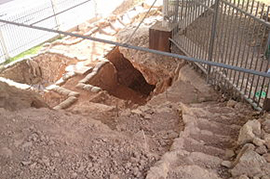
Qesem Cave Project
Qesem Cave is located 90 m a.s.l. in the western foothills of the Samaria Hills, ca. 12 km east of Tel Aviv, Israel. The sediments are some 10m deep, and all the stratigraphic sequence is assigned to the AYCC. The dominant industry in the sequence is the blade-dominated Amudian, while the scraper-dominated Yabrudian was found in three distinct parts within the stratigraphy of the cave. The speleothems from the cave were dated by U/Th to ca. 420-200 Kyr and a similar range as obtained by TL and ESR. Many burnt bones and flint items were found at Qesem Cave. In addition, ash was found in the cave's sediments. It appears that the use of fire was common throughout the sequence, including a repeatedly used, superimposed central hearth dated to ca. 300 ka. The faunal assemblage includes Dama mesopotamica (dominates the assemblage), Bos, Equus, Sus, Testudo, Cervus. The absence of all body parts indicates that carcasses were first processed outside of the site and only selected parts were brought to the cave. Furthermore, cut marks were abundant indicating butchering on-site.

Kanjera South Project
Kanjera South is located in the Homa Peninsula, southwestern Kenya. It is reach in lithic industry and fauna deposited in three beds (KS-1, KS-2, KS-3) dating approximately 2.30 Ma. The extensive excavation of the archeological occurrences for more than a decade and the related analyses, allowed to obtain a detailed picture of the local paleoenvironment at that time, of the fauna exploitation , of the lithic raw material exploitation and the knapping techniques that hominins carried out to make lithic tools. Lithic raw material consists of a great variety of rocks (igneous, sedimentary, metamorphic and metasomatised), the 28% of which are non-local and collected in stream and river conglomerates no closer than 10-13 km from Kanjera South. The core production modes change in relation to the exploited raw material and the non-local rocks arrived at the site especially as un-retouched or retouched flakes being derived from later stages of core reduction.
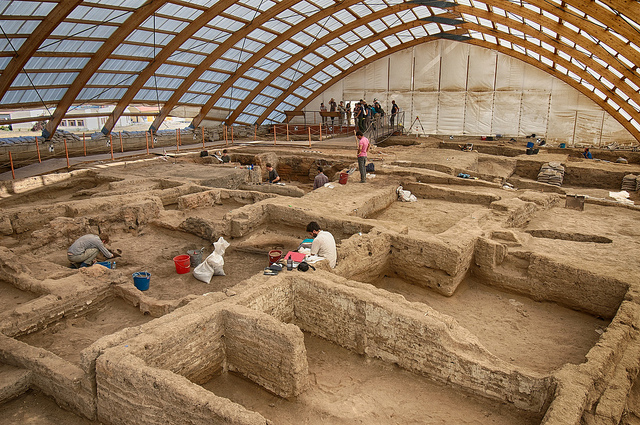
Çatalhöyük Project
Catalhöyük is a well known site located in Central Anatolia that was occupied for 2,000 years; the Neolithic East Mound dates from 7400 BCE to 6000 BCE and the Chalcolithic West Mound covers the first half of the 6th millennium BCE. The Pottery Neolithic village extends over many hectares suggesting a dense population in really ancient times. The Neolithic village is especially known for the evidences of rituals and symbolism expressed by burials, wall paintings and mural art. Catalhöyük is a key site for understanding the social and economic change that characterized the first farming communities of the Near East.
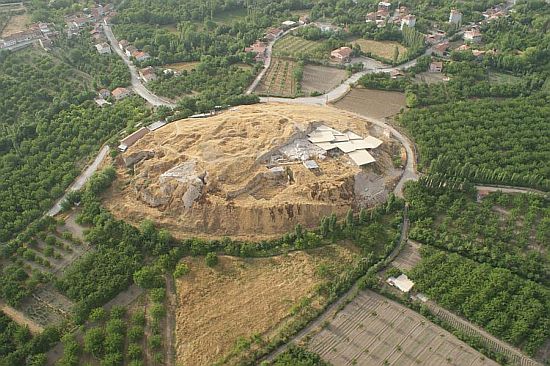
Arslantepe Project
Arslantepe is one of the most important archaeological excavations of “Sapienza” Università di Roma (Italy). Its great stratigraphic sequence covers a wide span of time from Late Chalcholithic to the Byzantine Age. The site is especially known for its Late Chalcolithic ‘palace’, evidence of the emergence of a centralized and redistributive economy, in association to the Uruk culture of the 4th millennium BC. At the beginning of the Early Bronze Age this socio-economic system collapses and new forms of organizations testified by village communities follow one another throughout the Early and Middle Bronze Age.

Traces Analysis of Textile Tools
LTFAPA laboratory has started a pioneering study of the production sequences and use of organic and ceramic spindle-whorls, ceramic bobbins, clay and ceramic loom weights through trace analysis.A long lasting experimental framework is in progress by C.Lemorini and V.Forte with the collaboration of craft specialists (A.Perilli, La Fonte della Tessitura; E. Ceccarelli,OfficinaTemporis) with the aim of create a first reference collection of technological and use traces.
F.Coletti is collaborating to the project for the residues analysis of the fibres observables on the textile tools. The archaeological materials under study with this approach cover a wide time spam, from prehistory to Roma period. In particular, we are part of a project coordinate by prof. M.Galli(“Sapienza” University), related to the study of the textile tools from Pompei.
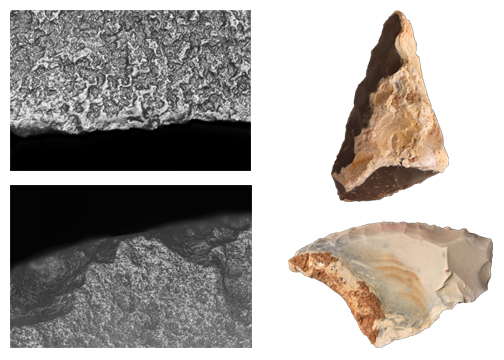
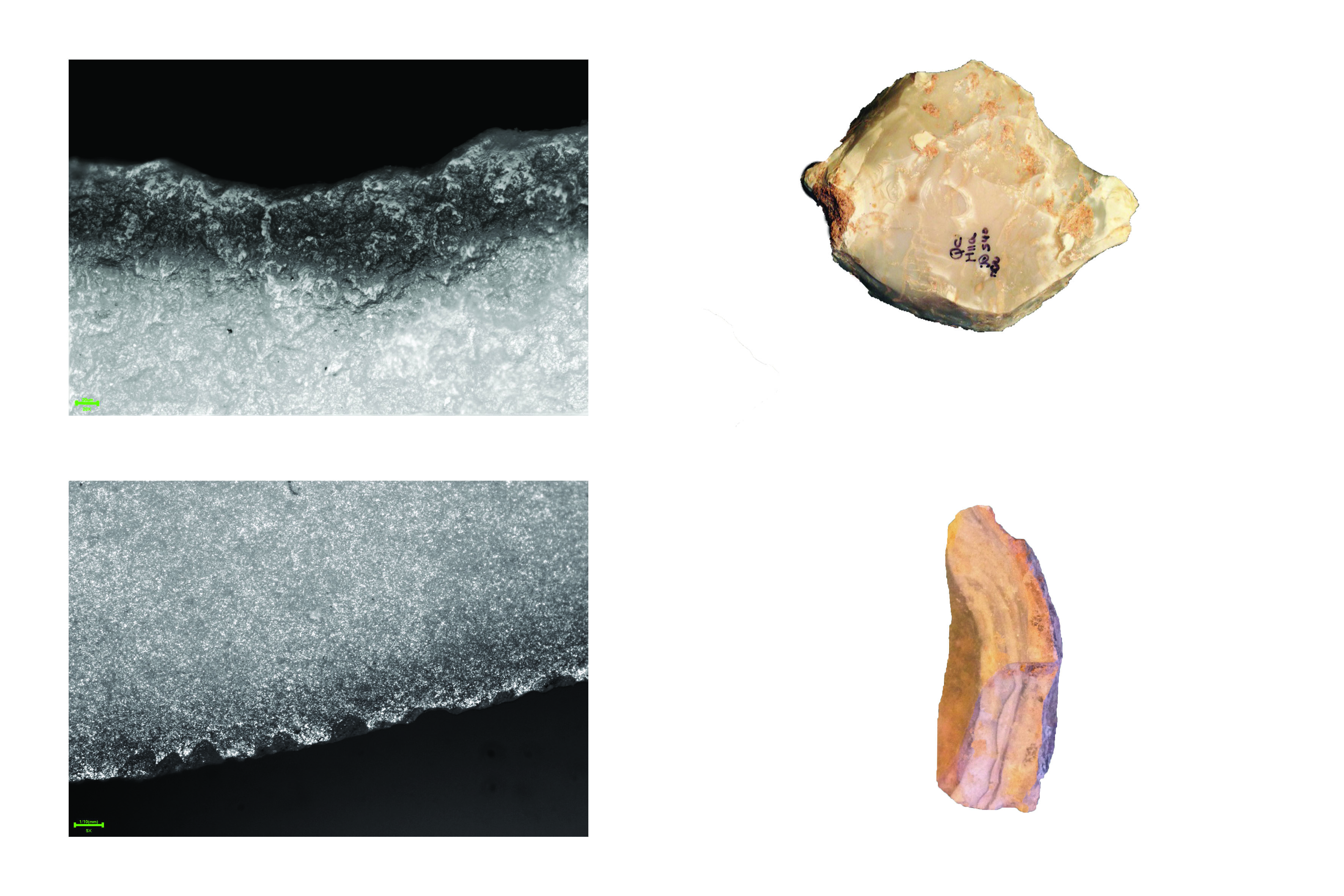
Qesem Cave (Israel)
The lithic assemblages unearthed at Qesem Cave is characterised by an outstanding degree of preservation, given the age of the site, dated between 400.000 and 200.000 years ago. This allows to exploit different techniques of analyses, focusing on the use of the lithic implements at the site. To this matter, the LTFAPA is currently undergoing three research projects, focusing on the use of Yabrudian Quina and demi-Quina scrapers, Recycled tools and Amudian blades. Both a Low and high Power approaches are applied in the analysis of the Qesem cave materials, along with the investigation of possible preserved residues through micro-FTIR. So far the use wear identified on the lithic tools at Qesem cave suggest the use of these latter to process different kind of materials, throughout various activities. Traces related to an intensive and prolonged processing of both fresh and dry hide characterise most of the Quina and demi-Quina scrapers found at the site, along with several examples of hard animal material processing and wood working. On the other hand, recycled tools and blades seem to have been exploited mainly to work soft substances, both vegetal and animal, mostly through cutting activities. Furthermore, organic residues have been identified on Quina, demi-Quina scrapers and recycled tools, providing significant direct evidence of the use of these items at the site. The ongoing researches projects carried out by the members of the LTFAPA at Qesem Cave are providing significant and new evidence related to the use of lithic artefacts at the site, improving the current knowledge on early human behaviours and cognitive capabilities.
Use Wear Related References
Lemorini, C., Bourguignon, L., Zupancich, A., & Gopher, A. (2015). A scraper ’ s life history : Morpho-techno-functional and use-wear analysis of Quina and demi-Quina scrapers from Qesem Cave , Israel. Quaternary International, 1–8. http://doi.org/10.1016/j.quaint.2015.05.013
Assaf, E., Parush, Y., Gopher, A., & Barkai, R. (2014). Intra-site variability in lithic recycling at Qesem Cave , Israel. Quaternary International. http://doi.org/10.1016/j.quaint.2014.07.071
Barkai, R., Lemorini, C., Shimelmitz, R., Lev, Z., Stiner, M. C., & Gopher, A. (2009). A blade for all seasons? Making and using Amudian blades at Qesem Cave, Israel. Human Evolution, 24(1), 57–75. http://cat.inist.fr/?aModele=afficheN&cpsidt=21275053
Lemorini, C., Stiner, M. C., Gopher, A., Shimelmitz, R., & Barkai, R. (2006). Use-wear analysis of an Amudian laminar assemblage from the Acheuleo-Yabrudian of Qesem Cave, Israel. Journal of Archaeological Science, (33), 921–934.
General References
Zupancich, A., Nunziante-Cesaro, S., Blasco, R., Rosell, J., Cristiani, E., Venditti, F., Lemorini, C., Barkai, R., Gopher, A., 2016. Early evidence of stone tool use in bone working activities at Qesem Cave, Israel. Sci. Rep. 6, 1–7. doi:10.1038/srep37686
Blasco, R., Rosell, J., Sañudo, P., Gopher, A., & Barkai, R. (2015). What happens around a fire: Faunal processing sequences and spatial distribution at Qesem Cave (300 ka), Israel. Quaternary International. http://doi.org/10.1016/j.quaint.2015.04.031
Falguères, C., Richard, M., Tombret, O., Shao, Q., Bahain, J. J., Gopher, a., & Barkai, R. (2015). New ESR/U-series dates in Yabrudian and Amudian layers at Qesem Cave, Israel. Quaternary International, 1–7. http://doi.org/10.1016/j.quaint.2015.02.006
Parush, Y., Assaf, E., Slon, V., Gopher, A., & Barkai, R. (2015). Looking for sharp edges: Modes of flint recycling at Middle Pleistocene Qesem Cave, Israel. Quaternary International, 361, 61–87. http://doi.org/10.1016/j.quaint.2014.07.057
Blasco, R., Rosell, J., Cuartero, F., Fernández Peris, J., Gopher, A., & Barkai, R. (2013). Using Bones to Shape Stones: MIS 9 Bone Retouchers at Both Edges of the Mediterranean Sea. PLoS ONE, 8(10), e76780. http://doi.org/10.1371/journal.pone.0076780
Parush, Y., Gopher, A., & Barkai, R. (2015). Amudian versus Yabrudian under the rock shelf: A study of two lithic assemblages from Qesem Cave, Israel. Quaternary International, 1–24. http://doi.org/10.1016/j.quaint.2015.01.050
Wilson, L., Agam, A., Barkai, R., & Gopher, A. (2015). Raw material choices in Amudian versus Yabrudian lithic assemblages at Qesem Cave: A preliminary evaluation. Quaternary International, 1–9. http://doi.org/10.1016/j.quaint.2015.02.015
Hershkovitz, I., Smith, P., Sarig, R., Quam, R., Rodríguez, L., García, R., … Gopher, A. (2011). Middle Pleistocene dental remains from Qesem Cave (Israel). American Journal of Physical Anthropology, 144(4), 575–92. http://doi.org/10.1002/ajpa.21446
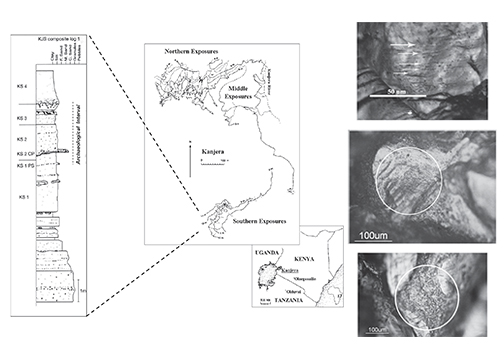
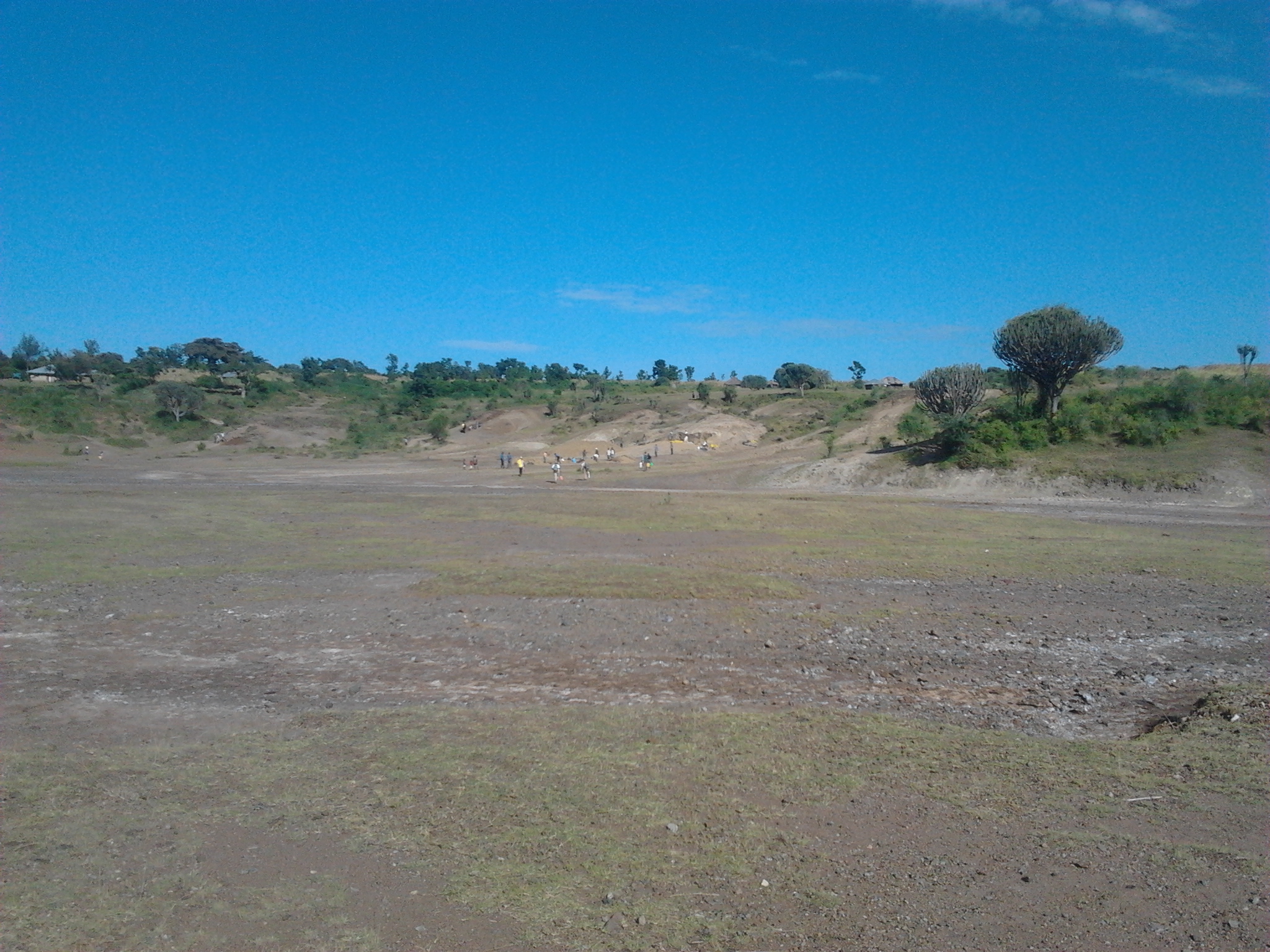
Kanjera South (Kenya)
The great state of preservation of the lithic industry, extremely rare in so ancient contexts and probably caused by the fast deposition of the artifacts in fluvial sediments, allowed to set up a research project of use-wear analysis aimed at analyzing the whole lithic industry found at the site which consists of several hundreds of artifacts. The use-wear analysis consists of a preliminary selection on the field of the artifacts showing traces of use followed by the making of silicone molds that are studied at the LTFAPA.The quartz and quartzite artifacts from excavation up to 2004 were analyzed combining Low and High-Power Approaches using a steromicroscope with a reflected light system and a metallographic microscope with a reflected light plus DIC system integrated with other observations made with a confocal system. Amazing data resulted from the use-wear analysis. Quartz and quartzite tools from Kanjera South were used not only for butchering but also for cutting and processing a variety of plants as wood, herbaceous plants and tubers. These data shed new light on the behavior of so ancient hominins suggesting that they were strongly familiar with plants exploitation probably not only for food purposes.The research project is going on with the analysis of the artifacts made of chert, ryolithe and fenetised. The two latter types of raw materials have an inhomogeneous micro-structure that needs a different observation approach than chert, quartz and quartzite. These materials are currently under study using observations with a Scanning Electron Microscope. In summer 2015, during the excavation season at Kanjera South, new experiments were carried out with replicas of the archeological artifacts with the aim of enriching the reference collection of use-wear to be kept at LTFAPA.
Use Wear Related References
Lemorini, C., Plummer, T. W., Braun, D. R., Crittenden, A. N., Ditchfield, P. W., Bishop, L. C., … Potts, R. (2014). Old stones’ song: Use-wear experiments and analysis of the Oldowan quartz and quartzite assemblage from Kanjera South (Kenya). Journal of Human Evolution, 2014. http://doi.org/10.1016/j.jhevol.2014.03.002
General References
Braun, D., Plummer, T., Ferraro, J., Ditchfield, P., & Bishop, L. (2009). Raw material quality and Oldowan hominin toolstone preferences: evidence from Kanjera South, Kenya. Journal of Archaeological Science, (36), 1605–1614.
Braun, D., Plummer, T., Ferraro, J., Ditchfield, P., Bishop, L., Potts, R., & Maina, D. (2008). Oldowan behavior and raw material transport: perspectives from the Kanjera Formation. Journal of Archaeological Science, (35), 2329–2345.
Plummer, T. (2004). Flaked stones and old bones: biological and cultural evolution at the dawn of technology. American Journal of Physical Anthropology, (39), 118–64.
Plummer, T., Bishop, L., Ditchfield, P., & Hicks, J. (1999). Research on Late Pliocene Oldowan Sites at Kanjera South , Kenya. Journal of Human Evolution, (36), 151–170.
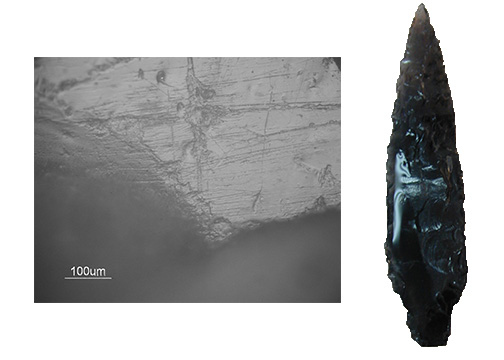
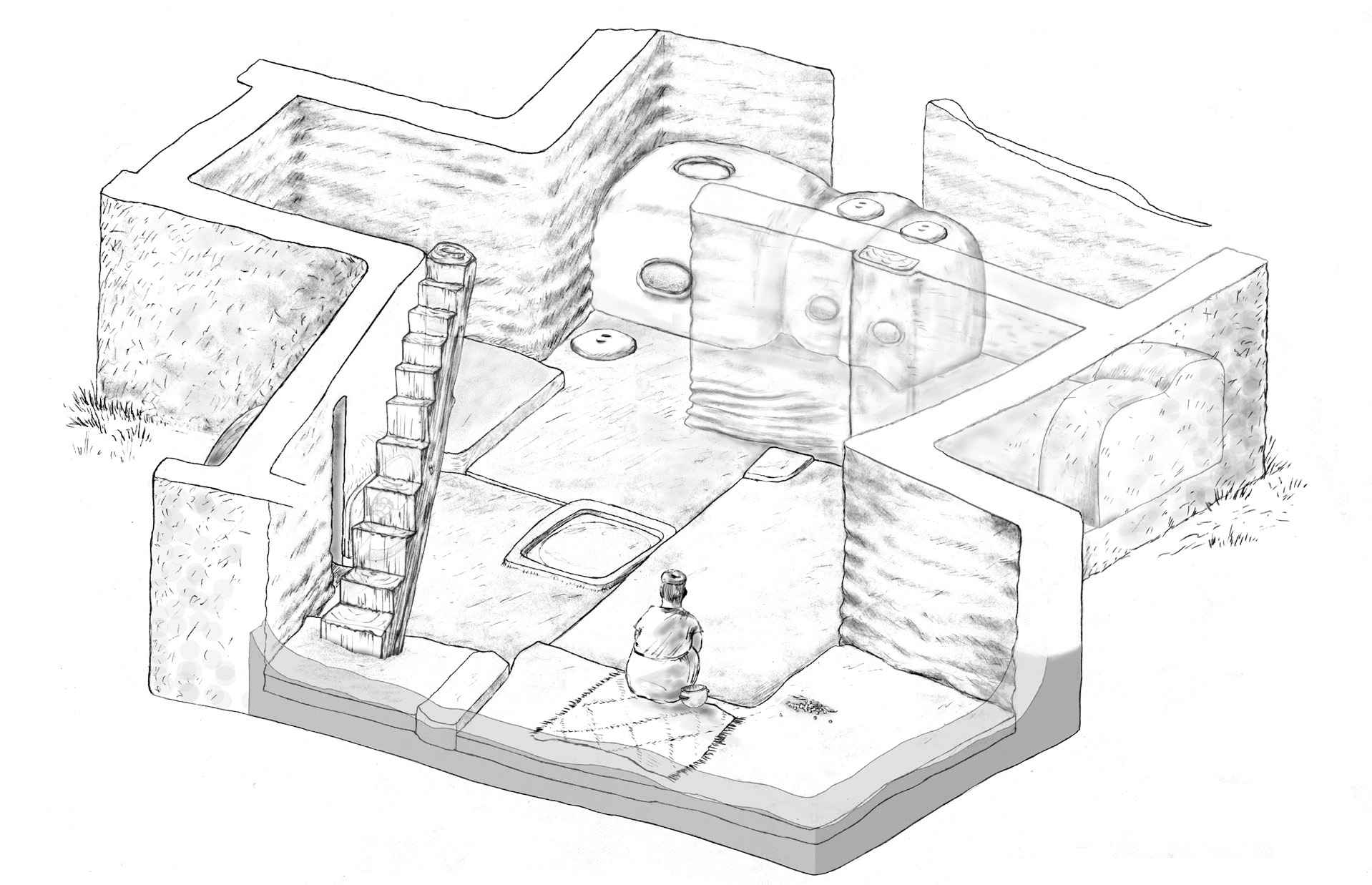
Çatalhöyük (Turkey)
Since 2013 the LTFPA is part of the Catalhöyük research team with a research project aimed at understanding the social and economic role of the chipped stone tools found in the Neolithic village using a use-wear approach. In particular, the project is focuses on the study of the activities carried out inside and outside the buildings as means for clarifying the role of different type of spaces in the social life of the village with a chronological perspective.The use-wear analysis consists of a preliminary selection on the field of the artifacts showing traces of use followed by the making of silicone molds that are studied at the LTFAPA with both Low and High-Power Approaches using a steromicroscope with a reflected light system and a metallographic microscope with a reflected light plus DIC system.Up to now, almost a thousand of artifacts, consisting especially of obsidian tools, the raw material most prevalent at Catalhöyük.The selection refers to chipped stone tools from buildings 65, 56, 44 and their related open spaces, midden and yards. These buildings are located in the same area, in the South Area of East Mound, and were build the one above the other in a sequence. The first results obtained by the detailed analysis of building 65 show a great variety of activities related to the gathering and processing of herbaceous plants. Crafts activities related to the production of small stone objects, as beads or similar, are present both inside and outside the building while butchering or hide processing were carried out mostly in the yard north of the building. Another selected buildings is building 77, located in the North Area of the East Mound. In contrast to the other selected ones this house has a more elaborated structure that suggests a different use than the domestic one ascribed to buildings 65, 56, 44.
Use Wear Related References
C.Lemorini, D.D’Errico, “Life at Ҫatalhöyük during Neolithic times. The contribution of microwear analysis of chipped stone tools to interpret the use and the manipulation of Neolithic domestic space” Unpublished talk at the AWRANA Conference held in Leiden (Netherlands), 27-30 May 2015:
Archive Reports 2013, 2014, 2015; http://www.catalhoyuk.com/archive_reports/
General References
For a complete list of references see: British Institute at Ankara Monographs; Monumenta Archaeologica Series and Çatalhöyük Archive Report http://www.catalhoyuk.com/archive_reports/


Arslantepe (Turkey)
Arslantepe is one of the most important archaeological excavations of the Sapienza University. Its great stratigraphic sequence covers a wide span of time from Late Chalcholithic to Byzantine Age. All the chipped stone tools, made of flint and obsidian, from Late Chalcolithic to Early Bronze Age excavated so far was analyzed with the use-wear analysis at LTFAPA providing a large amount of data regarding the use of stone tools for a wide variety of activities whether in domestic area or administrative places. At present, a PhD research project is investigating in details the agricultures practices at Arslantepe, their possible changes during times, the role of the élites in the organization of these practices using the data coming from the use-wear analysis of the chipped stone tools. This PhD project is based at Leiden University with the collaboration of LTFAPA. Moreover, LTFAPA is dealing also with the technological and functional study with traces analysis of the ground stones of the Arslantepe sequence, from Late Chalcolithic to Hittites Age. Other new lines of research were recently opened with two dissertations, respectively a B.A. dissertation on the production techniques of the stone beads from the Late Chalcolithic and Early Bronze Age levels of Arslantepe and a M.A. dissertation regarding the interpretation of the weaving techniques at Late Chalcolitic 5 VIA using an integrated approach of experimental archeology and traces analysis applied to the seals impressions on clay, “cretulae”, found in the storage areas of the administrative building.
Use Wear Realted References
Lemorini C. (2004), La contribution de l’analyse des traces d’usage à l’étude des contextes récents : le travail du bois et des végétaux à Arslantepe (Anatolie orientale), niveaux VII et VI A, Origini XXVI : 155-170.
Laurito R. & Lemorini C. (2007), Seal Impressions on Cretulae at Arslantepe:a new approach, Proceedings of the 4th International Congress on the Archaeology of the Ancient Near East Berlin, 29 Marzo - 3 Aprile 2004.
Laurito R., Lemorini C. & Cristiani E. (2008), Seal Impressions on Cretulae at Arslantepe: Improving the Methodological and Interpretative References, Proceedings of the 5th International Congress on the Archaeology of the Ancient Near East, Madrid, Maggio 2006.
Alvaro C., Lemorini C., Palumbi G. & Piccione P. (2008), From the analysis of the archaeological context to the life of a community. “Ethnographic” remarks on the Arslantepe VIB2 village, Proceedings of the 5th International Congress on the Archaeology of the Ancient Near East, Madrid, Maggio 2006.
Cristiani E., Laurito R. & C.Lemorini (2007), Technologies and Materials Used in Seal Manufacture at Arslantepe, Chapter IV, In Cretulae from Arslantepe-Malatya (Turkey): an Early Centralised Administrative System Before Writing, M. Frangipane (ed.), Arslantepe. Risultati delle ricerche e scavi della Missione Archeologica Italiana nell’Anatolia Orientale, vol. V, Rome: 355-377.
Lemorini C. (2010), Daily and ritual activities during the palatial phase. Wear traces analysis of chipped and ground stone industries. In: M.Frangipane (ed.), Economic Centralisation in Formative States. The Archaeological Reconstruction of the Economic System in 4th Millennium Arslantepe. Studi di Preistoria Orientale (SPO),vol. 3, Università Sapienza, Roma, pp. 241-254.
Piccione P. & Lemorini C. (2012), Vessels, tools and space use at Arslantepe in period VIB2. Everyday life in an EB I village, Origini – XXXIV:279-300.
Piccione P., Alvaro C., Bartosiewicz L., Lemorini C., Masi A. & Sadori S. (2015), Distribution of artifacts and ecofacts in an Early Bronze Age house in Eastern Anatolia: Space use and household economy at Arslantepe VI B2 (2900–2750 BCE), Journal of Archaeological Science: Reports 4, 8-22.
General References
Frangipane M. (ed.), 2004, Alle origini del potere. Arslantepe, la collina dei leoni, Mondadori Electa, Milano. Frangipane M. et al., 2007, Arslantepe Cretulae. An Early Centralised Administrative System Before Writing, Sapienza Università di Roma, 528 pp.
Frangipane M. (ed.), 2010, Economic Centralisation in Formative States. The Archaeological Reconstruction of the Economic System in 4th Millennium Arslantepe, Studi di Preistoria Orientale (SPO), volume 3, Sapienza Università di Roma
Other Ongoing Projects
La Polledrara di Cecanibbio (Lower Palaeolitich site, Italy) http://archeoroma.beniculturali.it/siti-archeologici/polledrara-cecanibbio
Valle Giumentina (Lower and Middel Palaeolitich site, Italy) https://cefr.revues.org/1081 http://mefra.revues.org/2658
La Ficoncella (Lower Palaeolitich site, Italy) http://www.archeologia.beniculturali.it/index.php?en/142/scavi/scaviarcheologici_4e048966cfa3a/30
Portonovo (Neolithic site, Italy)
Tas-Silg Sanctuary (Neolithic site, Malta)
Torre della Chiesaccia (Copper Age site, Italy)
Coppa Nevigata (Bronze Age site, Italy)
Ovuçlar Tepesi (Bronze Age site, Adzerbajian)
Ongoing Collaborations
Università degli Studi di Siena; Soprintendenza per i Beni Archeologici della Puglia; Soprintendenza Archeologica di Roma; Museo Nazionale di Villa Giulia; Soprintendenza per i Beni Archeologici dell' Etruria Meridionale; Stanford University; Tel Aviv University; Copenhagen University; Queens College; CUNY & NYCEP; Yale University; INRAP, Campagne; Université de Bordeaux I; Université Paris-Sorbonne; MSH Maison de l’Orient et de la Méditerranée, Université de Lyon 2 CNRS; École Française de Rome
Guest Researchers
Alice Vinet
Alice Vinet started her PhD in 2015 at the Paris 1 – Panthéon Sorbonne University in Paris. Her research focuses on the key issues of the Early Chalcolithic societies from Central Anatolia. Around 6000 BC, which correspond to the end of the Neolithic and the beginning of the Chalcolithic, important socio-economic changes took place in numerous of communities of Central Anatolia. While facing a population increase and new regional relationships, resulting from a millennium of sedentarism in western Anatolia, the villagers settled in new territories on the Anatolian plateau. Her project aims to study the cultural and economic interactions between two essential areas of the Anatolian Plateau: the Konya plain and Cappadocia. To document these interactions, she chose two contemporary sites: Çatalhöyük and Tepeçik Çiftlik. She is focusing on the obsidian industry, through a techno-functional approach. By comparing two lithic collections, she is addressing the socio-economic and cultural similarities and differences at a supra-regional scale.
https://www.researchgate.net/profile/Alice_Vinet
https://univ-paris1.academia.edu/AVinet
http://www.trajectoires.cnrs.fr/spip.php?article147
http://www.cepam.cnrs.fr/spip.php?article2444
Email
ltfapa@uniroma1.it
Address
Museo delle Origini
Università Sapienza di Roma
Piazzale Aldo Moro,5
00136
Italy
Phone
(0039)0649913924